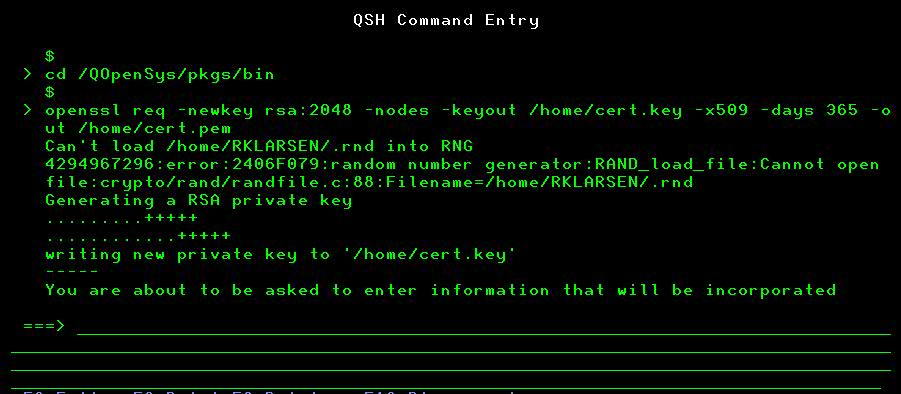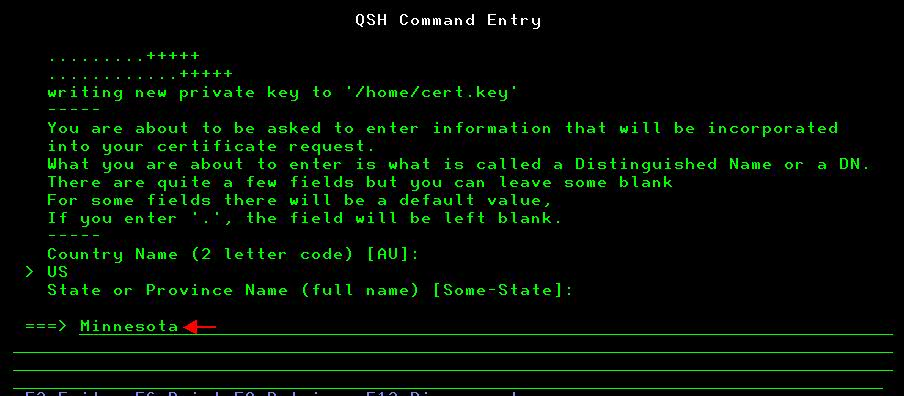About cookies on this site Our websites require some cookies to function properly (required). In addition, other cookies may be used with your consent to analyze site usage, improve the user experience and for advertising. For more information, please review your options. By visiting our website, you agree to our processing of information as described in IBM’sprivacy statement. To provide a smooth navigation, your cookie preferences will be shared across the IBM web domains listed here.
How To
Summary
This document will go through the steps to enable NGINX for SSL on the IBM i with support for the following protocols:
TLSv1.3
TLSv1.2
TLSv1.1
NGINX uses OpenSSL for its' SSL implementation and OpenSSL 1.1.1+ natively allows for TLSv1.3. As of this writing (12/6/18) TLSv1.3 is not available in IBM i System SSL.
Environment
Requirements
- The OS must be at V7R2 or higher
- NGINX must be installed
- OpenSSL 1.1.1+ must be installed
NGINX Installation instructions:
https://www-01.ibm.com/support/docview.wss?uid=ibm10743711
NOTE: If you need to update the existing version of OpenSSL or NGINX we can use the following documentation to access the Open Source Package Management utility and update the products:
Steps
The NGINX server requires two files to enable SSL, one file with a '.key' extension contains the private key for the certificate, the other file with a '.pem' file extension hold the public key. The server can use either locally generated certificates or one from a well known Certificate Authority (CA).
1) The first step is to obtain the SSL certificate we would like to use for the server. This can be either a locally generated certificate from OpenSSL or one exported from Digital Certificate Manager (DCM):
2) Now that we have our '.pem' and '.key' file we need to edit the NGINX configuration to have the following lines inside the server{} block:
ssl_certificate /home/cert.pem;
ssl_certificate_key /home/cert.key;
ssl_session_cache shared:SSL:1m;
ssl_session_timeout 5m;
ssl_protocols TLSV1.1 TLSV1.2 TLSV1.3;
ssl_ciphers HIGH:!aNULL:!MD5;
ssl_prefer_server_ciphers on;
For example:
server {
listen 443 ssl;
ssl_certificate /home/cert.pem;
ssl_certificate_key /home/cert.key;
ssl_session_cache shared:SSL:1m;
ssl_session_timeout 5m;
ssl_protocols TLSV1.1 TLSV1.2 TLSV1.3;
ssl_ciphers HIGH:!aNULL:!MD5;
ssl_prefer_server_ciphers on;
root "/QOpenSys/etc/nginx/html/";
location / {
index index.html index.htm;
}
}
3) Once the NGINX configuration has been updated we need to either stop/start the server, or perform a reload operation:
A) On the IBM i command line type STRQSH
B) Type the following commands to stop/start the server:
cd /QOpenSys/pkgs/bin nginx -s stop
nginx
NOTE: If you want to use a different configuration than the default '/QOpenSys/etc/nginx/nginx.conf' you would use this command to start it instead:
nginx -c /path/nginx.conf
If you would like to perform a reload instead of a stop/start run the following command:
nginx -s reload
The reload will gracefully end the existing worker processes and start new ones, which will pick up the new configuration changes.
4) You now should be able to access the site with SSL and be able to view the SSL certificate and see the connection information.
Additional Information
NGINX Product Documentation:
https://www-prd-trops.events.ibm.com/node/how-configure-nginx-ssl-ibm-i
[{"Business Unit":{"code":"BU058","label":"IBM Infrastructure w\/TPS"},"Product":{"code":"SWG60","label":"IBM i"},"Component":"","Platform":[{"code":"PF012","label":"IBM i"}],"Version":"V7R2;V7R3","Edition":"","Line of Business":{"code":"LOB57","label":"Power"}}]
Was this topic helpful?
Document Information
More support for:
IBM i
Software version:
V7R2, V7R3
Operating system(s):
IBM i
Document number:
744529
Modified date:
18 December 2019
UID
ibm10744529
Manage My Notification Subscriptions















